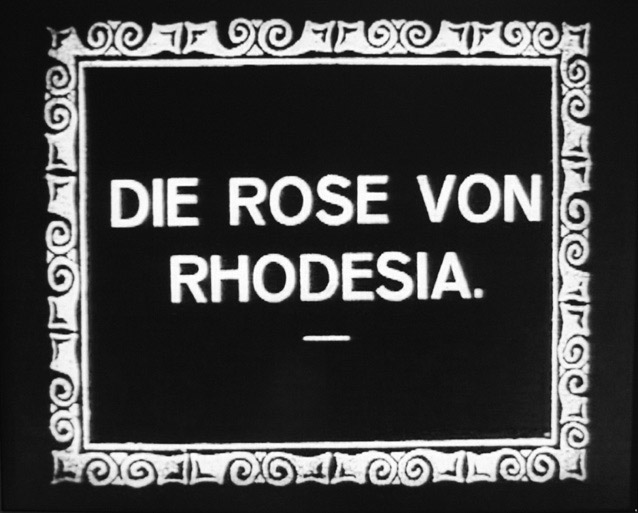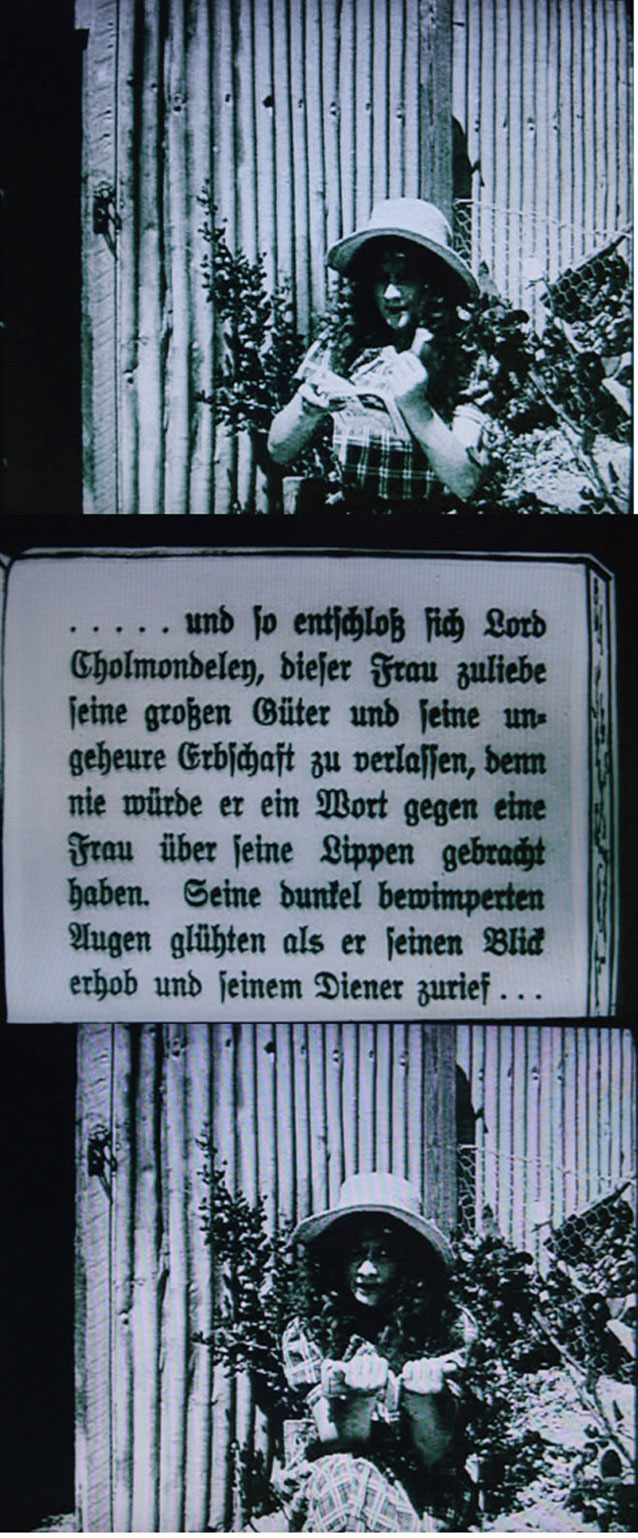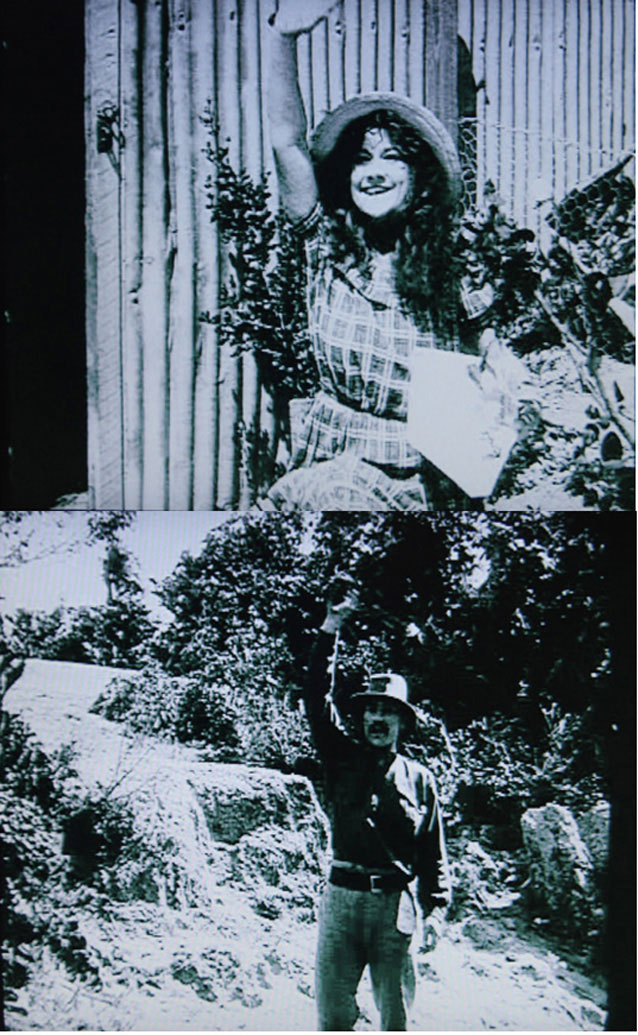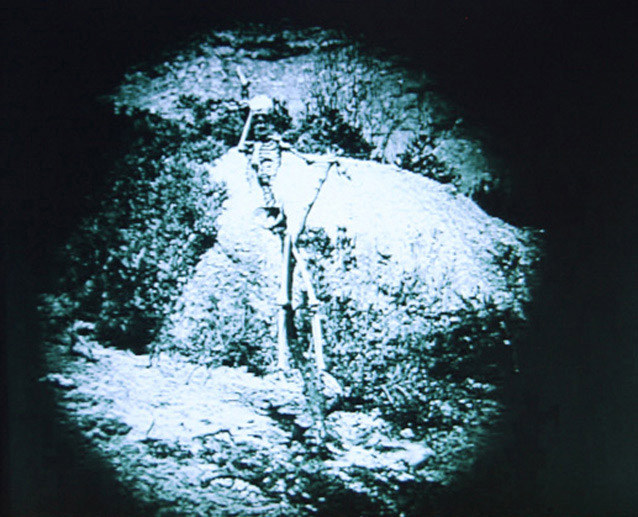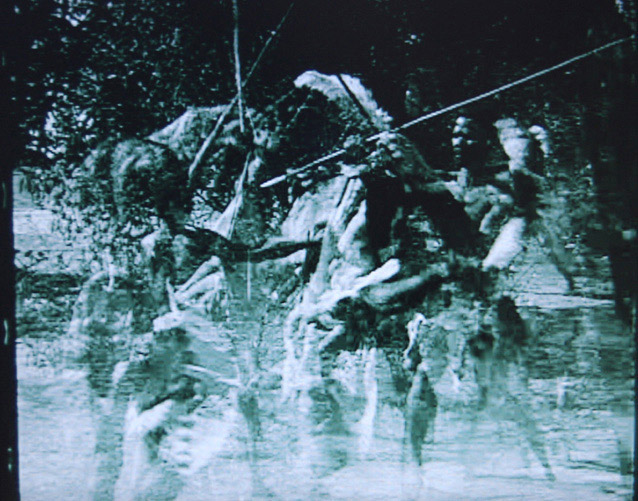Abstract
This essay aims to give a more general introduction to the film-historical context surrounding The Rose of Rhodesia (1918). What was it like to make films in the late 1910s? What was it like to go to the cinema? And what might the film’s first audiences have considered The Rose of Rhodesia’s merits? In an attempt to answer these questions, this essay focusses on Britain, where director Harold M. Shaw spent a significant amount of his career and where The Rose of Rhodesia premiered in October 1919. The argument that is developed is that The Rose of Rhodesia ought to be understood in the tradition of the “feature film”, which in the 1910s followed a particular format: a compilation of narrative elements with visual attractions.
Silent films can be alien objects indeed. Lacking synchronized sound and natural colour, and featuring long scenes and an exaggerated acting style, The Rose of Rhodesia does not quite give the same pleasure as, say, the latest James Bond movie. It is impossible to overlook the fact that ninety years have passed since this African feature first hit the big screen. Back then, however, the film was every bit as entertaining as James Bond is for us today—or so, at least, it was intended to be. The present essay will seek to bridge this historical divide by exploring the production and viewing contexts of The Rose of Rhodesia. In order to deepen our understanding of both its aesthetics and its place in silent film history, I ask: What was it like to make films in the late 1910s? What was it like to go to the cinema? And what might the film’s first audiences have considered The Rose of Rhodesia’s merits?
Where other contributions to this collection, notably those by Neil Parsons and James Burns, address aspects of early South African film culture, this essay will focus on the situation in Britain, where director Harold M. Shaw spent a significant part of his career and where the film premiered in October 1919. As well as reviewing some key aspects of early film history, I will examine relevant aspects of what is known of Shaw’s biography in light of how The Rose of Rhodesia was marketed and reviewed in British film trade journals. The argument I will be developing is that the film’s fundamental alterity, that is to say, its strangeness for the viewer in 2009, cannot be explained away on the grounds that filmmaking was less sophisticated in the 1910s than today. Rather, it needs to be understood that The Rose of Rhodesia is organized around, not one, but several aesthetic ideals, and that this was common practice for early feature films.
Beginnings
In 1917, when The Rose of Rhodesia was shot, cinema was still a fairly new type of entertainment. The first successful attempts at projecting a series of photographs in order to create the illusion of movement had been made little more than two decades previously. At the turn of the century, the technology itself remained the biggest marvel. The very fact that objects moved on the screen fascinated spectators, and the first films typically consisted of a single shot lasting no longer than a minute. Scholars have termed this earliest phase of film history “the cinema of attractions”, defining it as primarily “dedicated to presenting discontinuous visual attractions, moments of spectacle rather than narrative” (Gunning 2005, 124).[1] The cinema of attractions was the dominant format until about 1903-1907, after which films became longer and increasingly geared towards storytelling.
Harold M. Shaw first made contact with the new medium in 1909. After starting out as a stage actor, he was hired by the New York-based Edison Manufacturing Company. Owned by legendary inventor Thomas A. Edison, the company was one of the largest film producers in the world (see Musser 1991). Films at this stage typically lasted 15 minutes, the length of one reel of film, and the Edison Company turned out several of these so-called one-reelers every week. Shaw appeared in many of them before becoming a director, and it was while directing at the Edison studios that he met Edna Flugrath, later his wife and The Rose of Rhodesia’s leading lady. Edison films for which both Shaw and Flugrath are credited include The Dam Builder (1912) and a Western titled At Bear Track Gulch (1912).[2]
The trend in the early 1910s was towards even longer films, so-called multi-reelers or feature films lasting anywhere from forty-five minutes to three hours (Grieveson and Krämer 2004, 187f.). During this phase, cinema acquired a great deal of cultural status. No longer merely a dubious pastime for the working classes, women, and children, it came to be perceived as a serious competitor to the theatre and even as an art form in its own right, one capable of attracting wealthier, middle-class audiences. The new self-esteem of the movie business, increasingly professionalized and industrialized in character, also found expression architecturally in the lavishly designed movie palaces which began to replace older neighbourhood venues.
As films grew in length, storytelling became more complex, forcing filmmakers to find ways in which to ensure narrative clarity. Although synchronized sound would not be introduced until the late 1920s, a crucial innovation in 1903 was the use of intertitles containing either story information or passages of dialogue. Editing the images also became increasingly important as a means of guiding audiences through the plot and heightening their emotional involvement and identification with the on-screen characters. During the 1910s, a set of narrative conventions emerged as the dominant editing style. Scholars today refer to it as “classical Hollywood cinema” in recognition of Hollywood’s establishment as the Mecca of the film business at the time the system was introduced (see, for example, Bordwell, Staiger, and Thompson 1985). By 1917, the narrative approach of classical Hollywood cinema had been firmly established, and despite the addition of many refinements during subsequent years, its basic principles continue to be used to the present day.
Classical Hollywood cinema advocated a number of specific techniques. One was the “crosscutting” or “parallel editing” of two or more actions taking place at the same time but in different locations. Another standard device, intended to focus the spectator’s attention upon important details within a scene, was to insert “cut-ins” of close-up shots, a method that also served to reveal the actors’ facial expressions more clearly. Other conventions included the “eyeline match”, a shot showing a character looking off-screen followed by a shot of what he or she is looking at. In similar fashion, dialogue between two characters could be staged through the “shot/reverse shot” which presents two people facing each other in two separate shots: shot one shows the first character looking off-screen to the left; shot two shows the second character looking off-screen to the right.
The establishment of cinematic conventions such as these enabled filmmakers to compose scenes using numerous shots without confusing the audience. Rather than merely presenting a scene using a single shot filmed from a distance, a far more dynamic visual design became possible. The sophistication of this new mode of cinematic storytelling was demonstrated by American director D. W. Griffith in his controversial historical epic The Birth of A Nation (1915). An unprecedented international success, this eight-reel “super-film” about the American Civil War and Reconstruction quickly achieved mythic status among audiences as a milestone in the history of the new medium. Rather than a recognition of Griffith’s supposed genius, however, the instant fame of The Birth of A Nation should also be understood as the result of deliberate propaganda strategies on the part of the film business, which now sought to attract a better-paying crowd to cinemas (Hammond 2006, 138 and passim).
In Europe, American productions in general were increasing their market share rapidly. In 1914, only a quarter of the films shown in British cinemas were produced in Britain (Baillieu 2002, 15).[3] Though France was exporting many films to Britain at this point, it was above all Hollywood productions that came to dominate the market. The popularity of American films prompted British businessman Ralph Jupp to recruit American staff when he founded his production company, the London Film Company, in 1913; Jupp’s new hires included Harold Shaw and Edna Flugrath, who both set sail for Europe. The transition seems to have been timely. The Edison Company had begun to suffer heavy financial losses, in part because it had failed to adapt to the popularity of feature-length films (Musser 1991, 471), and Shaw and Flugrath were among an exodus of directors and actors at around this time.[4]
Shaw directed the London Film Company’s first film, a prestigious five-reeler titled The House of Temperley(1913), based on Arthur Conan Doyle’s Rodney Stone (1909) and featuring Edna Flugrath in a leading role. The film scored a considerable success and set the standard for future London Film Company films. By the time he left for Africa in 1916, Shaw had directed a total of thirty-three films for Jupp, including features as well as shorts.[5] In addition to relying on American expertise, Jupp developed a business profile based on “quality productions”: films with a relatively high budget whose content targeted a better-off clientele with more refined tastes. Many of these were literary or stage adaptations, such as Charles Dickens’s A Christmas Carol (1914) and George de Maurier’s Trilby (1914). By the outbreak of the First World War, the London Film Company had established itself as one of Britain’s principal film production companies (Low 1973, 110f.).
Reliance on adaptations was extremely widespread in Britain at that time. Film historian Rachael Low estimates that by the middle of the 1910s as much as ninety-five percent of British film production did not feature an original story (Low 1973, 61). This dependence on other narrative arts was the object of harsh criticism. Commentators both at the time and subsequently considered the British silent films of the 1910s as “backward”, particularly compared to American moviemaking. In her influential study, Rachael Low notes that “most British films of the period, when examined for artistic merit, seem better forgotten.” (Low 1973, 175) Nevertheless, she explicitly mentions the London Film Company’s productions as among the few exceptions to this uncompromising generalization.
More recently, scholars have come to rediscover and defend British cinema of the 1910s. Amy Sargeant points out that Britain was far from unique in its reliance on screen adaptations, and that many other national cinemas incorporated the same strategy in early feature films (Sargeant 2005, 29). Perhaps even more important in this context is that the critics’ dismissal of British film production rests on the assumption that classical Hollywood cinema was an aesthetically superior or representationally more faithful mode of filmmaking. Low’s praise for the London Film Company’s features, in other words, stems not only from the fact that Jupp’s budgets were fairly large by British standards of the time but also because the style of his films most closely followed Hollywood conventions.
Film historians today, however, no longer regard classical Hollywood cinema as aesthetically superior. The international dominance of the Hollywood system is less a matter of aesthetics than of economic interests, interests which the American film industry was able to promote very successfully in the 1910s and onwards. As a result, recent scholarship on early film has increasingly come to acknowledge the existence of a plurality of narrative or aesthetic standards in the 1910s, none of them intrinsically ”better” than the others (see, for example, Higson 2002, 6f.).
Hollywood Style
By the time he directed The Rose of Rhodesia, Shaw had become an experienced and renowned filmmaker. Edna Flugrath, the leading lady in most of his films, had also become something of a “star”.[6] Both the term and the concept of “stardom”–a quality that raised actors, and particularly actresses, to the skies—were of recent provenance in the 1910s.[7] Although the star system was less developed in Britain than in the United States, Flugrath was featured on the cover of fan magazines, such as Pictures and Picturegoers on 6 May 1916 and 17 May 1919 (Fig. 5.1), while her younger sisters Virginia and Leonie went on to become even greater stars in Hollywood under the stage names of Viola Dana and Shirley Mason.
Thanks to his training in American film studios, Shaw was familiar with the techniques of classical Hollywood cinema. He knew how to use them to good effect, as is amply evidenced by the array of editing techniques that can be seen at work in The Rose of Rhodesia. Among the new narrative devices used in the film is Shaw’s cross-cutting of several plotlines taking place simultaneously. Thus, on the one hand, we have the missionary James Morel and his son Jack living in close proximity to the kraal of Chief Ushakapilla and his son Mofti. Meanwhile, a second narrative strand is introduced with the theft of the diamond by Fred Winters in a remote city, and a third develops around Rose Randall and her father Bob, an unsuccessful gold-digger, at their veldt camp at Green Willow. These three parallel worlds become interwoven in the course of the film as the protagonists successively cross each other’s paths.
Following common film practice of the day, The Rose of Rhodesia creates a coherent story by using intertitles that represent key lines of dialogue as well as interventions by an omniscient narrator. Other variations include the use of intertitles representing newspaper articles, books, and letters to supply plot information. These “diegetic” intertitles—that is, intertitles originating from a source within the film’s world—are also cut-ins insofar as the first shot shows one of the screen characters holding the book or letter in question before a second shot reveals in close-up what he or she is reading (Fig. 5.2). The film relies, too, on numerous eyeline matches and shot/reverse shots (Fig. 5.3).
In order to direct the spectator’s attention, silent movies often resorted to irising, that is, the circular masking of a shot. Shaw employs this device in the beginning of the film to provide a first glimpse of the missionary’s hut. The masking effect in this instance can be said to function as a shorthand way of underscoring the kraal’s location in what the intertitle describes as “out in the wilderness” (Intertitle 10). Irising is used a second time when Ushakapilla tells his subjects to gather gold and diamonds (Fig. 5.4). Ushakapilla’s warning that those who do not obey his orders will be punished by death is not stated explicitly; rather he is shown pointing off-screen. There follows an irised shot of a skeleton, whose significance is explained by a further intertitle representing Ushakapilla’s direct speech: “That will be the fate of all those who come back without gold or diamonds. I have spoken!” (Intertitle 21). The masking here may thus be said to heighten the dramatic effect of the imagery.
Another prominent cinematic technique in the film is Shaw’s use of superimposition or double exposure to represent Ushakapilla’s dream (Fig. 5.5). In the silent era, trick shots of this kind were an especially popular device for staging dream sequences. The impact of double-exposed scenes was in many cases enhanced through the use of colour. As Paolo Cherchi Usai notes, the great majority of films made between 1908 and 1925 were coloured using techniques of tinting or toning (Cherchi Usai 2000, 23). A common practice was to dye entire sequences in different colours depending on whether they were indoor or outdoor scenes, or whether the action was taking place in daytime or at night. A dream scene, in turn, might be rendered using a contrasting tone such as purple. And, while it is difficult to determine whether this was indeed the case in The Rose of Rhodesia, it cannot confidently be ruled out. The colouring was often decided by the distributor and could vary greatly among copies of the same film. In the copy of The Rose of Rhodesia that has survived in the Nederlands Filmmuseum, it seems that only the intertitles had been tinted in a different colour than the rest of the film.[8]
Whether coloured or not, we can conclude that The Rose of Rhodesia closely followed contemporary cinematic practices of the 1910s. Of course, that does not necessarily make it a successful or even a good film. To gain a sense of how audiences in Britain in 1919 might have perceived the film, let us turn to reviews of The Rose of Rhodesia’s premiere at a London trade screening on 28 October 1919.
Reading the reviews in The Kinematograph Weekly and The Bioscope, two of Britain’s leading film trade journals, one is struck by the divergence of opinion about Shaw’s latest offering. The reviewer for The Kinematograph Weekly is on the whole more positive towards the film than his colleague in The Bioscope, pronouncing The Rose of Rhodesia “a carefully constructed story” (The Kinematograph Weekly, 6 November 1919, 115) in which “three threads of the plot are woven together with exceptional skill” (116). In contrast, the critic in The Bioscope complains: “The story of the film is thin, conventional and rather clumsily constructed …. At present rather ragged and jumpy, the film could be greatly improved by careful editing” (The Bioscope, 6 November 1919, 99).
This criticism highlights a number of inconsistencies and jumps in the film. For example, when Fred Winters is arrested in the bar at Green Willow, we are given only very limited information about how the inspector recognizes Winters as the diamond thief. Similarly, towards the end of the film, there is no scene showing Rose’s decision to return the Rose Diamond to the Karoo Mining Syndicate; the story jumps from her receiving the diamond to her getting a reward for handing it over a week later. (How does Rose know this diamond is the Rose Diamond, or who its rightful owner is?) The viewer’s suspicion that something has been left out is particularly acute in the incident in the fourth act in which a newspaper falls from a passing train. This elaborate scene presents a view of the train and an interior shot of a passenger whose newspaper is fortuitously blown by a gust of wind into the hands of Jack Morel, who just happens to be passing by. Instinctively, the viewer assumes that this must have some bearing on the story: does the newspaper contain key information leading to Winters’ arrest? Yet this is not the case. Jack merely gives the newspaper to his father, while in another scene he hands a newspaper to Fred Winters with the remark: “I thought you might enjoy reading some news from back home…” (Intertitle 86). The scene with Winters, however, takes placebefore the newspaper falls off the train, which means that there must somehow be two newspapers involved, neither of which is significant for the story.
How should we explain these inconsistencies? It is not unusual for films from the silent era to have been preserved in an incomplete version, some of whose parts have been lost or damaged over the years. However, in the case of The Rose of Rhodesia, the comment by The Bioscope reviewer about poor editing suggests that these jumps—or at least some of them—were there from the beginning. For a director of Shaw’s calibre, these violations of the Hollywood continuity system are surprising. It is possible that they resulted from production difficulties. What nevertheless seems even more important in this context is the fact that, as Neil Parsons has shown, The Rose of Rhodesia was advertised as a seven-reeler when it premiered in South Africa but as a five-reeler when it came to Britain. Since one reel is roughly equal to fifteen minutes, the version we have today would indeed seem to be five rather than seven reels in length. Although the reference to seven reels could have been a mistake, it is more likely that Shaw re-edited the original film prior to its European release, cutting it by almost a quarter. So radical a shortening of the film would almost inevitably have affected its narrative continuity negatively.
Even so, it needs to be borne in mind that the same story which The Bioscope reviewer condemns as “thin and jumpy” is praised by his colleague in The Kinematograph Weekly as “well-constructed”. More important than the question of which critic is right (or more observant) is the crucial fact that, at this precise historical moment, it was possible to form such wholly antithetical opinions about a film’s narrative coherence. This discrepancy, as I will elaborate in the following section, serves to illustrate how, in the 1910s, adherence to the new codes of Hollywood storytelling was only one criterion among others for the critical evaluation of a film.
The Variety Format
A crucial characteristic of 1910s and 1920s cinema is that feature films were typically shown with a full supporting program of other items (Grieveson and Krämer 2004, 193, 274f.). This included a wide range of shorter films, typically one- or two-reelers, ranging from comedies, slapsticks, and cartoons to newsreels and travelogues. Sometimes the program even contained live acts and musical performances. This variety format was central to audience’s expectations. Although the feature-length film was the main attraction, the sideshow was important. Polls taken in the 1920s record that 68 percent of the audience went to the cinema for the overall “event”, and only 10 percent to see the featured movie specifically (Grieveson and Krämer 2004, 275).
Offering a wide variety of pleasures to a diverse mass audience was not only the principle behind film exhibition in the 1910s, it also came to shape the feature films themselves. Realizing narrative integration à la Hollywood, in other words, was just one goal for a feature film director; as important was offering a multitude of other spectacles capable of satisfying a broad range of viewer interests. In this sense, the film narrative served as a framework for the presentation of an array of visual (and aural) pleasures. Some film scholars have situated this distinct compilation strategy of early feature films within the tradition of stage melodrama and popular fiction, which foregrounded the elements of “sensational action, violence, thrills, awesome sights, physical spectacle and heightened emotional states” (Grieveson and Krämer 2004, 274). A growing number of other scholars have emphasized the continuity of older principles in this context, namely, those of the cinema of attractions.
Approaching The Rose of Rhodesia by way of the attraction or variety format makes sense of much in the film that can seem awkward to audiences today. For example, why the apparently redundant scene of the newspaper falling from the train was not eliminated becomes more comprehensible when one knows that the footage of a train running through the desert was a visual spectacle in its own right.[9] Indeed, landscape views taken from trains—so-called phantom rides—were among the most popular motifs or genres in the earliest phase of cinema.
The fact of having been shot on location—not, as the title misleadingly suggests, in Rhodesia, but in Africa nevertheless—would have been the single most important attraction which The Rose of Rhodesia offered to its British audiences. The reviewers for The Kinematograph Weekly and The Bioscope both refer to the film’s landscape views and footage of native life as key assets. Capturing images of exotic and faraway places on camera was, of course, a sales concept that had been applied by the Lumière brothers as far back as the late 1890s. Even so, public demand for such images was far from exhausted in the 1910s and 1920s. And numerous articles in the European trade press attest to the risks and challenges faced by filmmakers in Africa at this time.[10] Accounts of the latest expeditions to the African continent emphasized the special hardships endured by film crews, ranging from the challenges posed by the climate—extremes of light and heat could ruin the film stock—to the supposed superstition of locals about being photographed (see, for example, Schomburgk 1922).
Authentic African footage combined with a romantic drama promised to be a unique selling-point. It is on these grounds that The Bioscope reviewer speaks of The Rose of Rhodesia as a “decided novelty” and further recommends that preliminary titles should be added to the film emphasizing the “genuineness” of the scenes (The Bioscope, 6 November 1919, 99). The promotional materials for The Rose of Rhodesia did indeed foreground the supposed genuineness or authenticity of its African footage (see Fig. 5.6). Using a production still as a full-page advertisement was very unusual in the trade press at this time. Where advertisements did include pictures, these were typically drawings, not infrequently sensationalizing, with photographic material used only rarely in so dominant a fashion. Just as the magnitude of the production still serves to advertise the ”authentic” location footage, so, too, does the smallness of its actors suggest that the film’s real star will be the dramatic African scenery.
These unconventional marketing strategies need to be seen in context. In the 1910s, the most common way of representing an exotic landscape in a feature film was to recreate it in a studio setting at home. Shaw’s The Ring and the Rajah (1914), for example, was supposedly set in India but was entirely shot at the Twickenham studios near London. As late as in the 1920s, the German director Hans Schomburgk was offering a compromise approach that combined documentary footage shot in Africa with fictional scenes re-enacted in a studio in Berlin (Oksiloff 2001, 83f.). Besides Shaw, whose previous film De Voortrekkers (1916) had also been shot on location in South Africa, only a few others (such as I. W. Schlesinger’s African Film Productions) were offering British cinemagoers film dramas shot in Africa.
Alongside its “gorgeous African landscapes” (The Bioscope, 6 November 1919, 99), The Rose of Rhodesia contains a good many scenes of kraal life and customs, scenes with little, if any, plot significance. Rather, these must be situated in the context of a broader colonial-ethnographic project. The viewing public’s appetite for “authentic” footage, as Emma Sandon has noted in her study of two ethnographic feature films about Africa that were produced in the late 1920s, strongly parallels contemporary ethnographic exhibition practices in which particular emphasis was placed on the creation of shows of artefacts—and even living human beings—brought from Africa (Sandon 2002, 199f.). Examples include the visit to the witch doctor, and, above all, the dance scene, whose presence in the narrative is weakly motivated as an element of Ushakapilla’s dream about his ancestors. Indeed, the attraction offered to contemporary audiences by this scene would have been two-fold, offering both a depiction of African customs and the visual pleasure of an optical spectacle (the double exposure).
As the reviews make clear, the prospect of watching Africans in dramatic roles was another of The Rose of Rhodesia’s main attractions, as here enumerated in the telegraphic summary which prefaces The Bioscope review: “Interesting South African picture includes scenes acted by real native players” (6 November 1919, 98). Both The Bioscope and The Kinematograph Weekly critics devote relatively large portions of their reviews to the performance of the “natives”: “The acting both of Chief Kentani and of Prince Yumi as the Chief and his son is extraordinarily good. In fact it seems that they simply live their parts” (The Kinematograph Weekly, 6 November 1919, 116). Such praise was clearly informed by racist stereotypes: their performance is good precisely because, far from acting, they are their parts. The Bioscope’s description of Kentani and Yumi’s acting as “a histrionic curiosity that should not be missed” (6 November 1919, 99) nevertheless needs to be weighed against the fact that at this point most black roles were played by white actors in blackface. Indeed, a debate had started in the trade press only a few months prior to the release of The Rose of Rhodesia over whether black actors might ever become movie stars (see Bourne 1998, 10-11).
For The Bioscope’s critic, this “histrionic curiosity” more than compensates for the film’s “thin and jumpy story”, while the reviewer for The Kinematograph Weekly concludes that “it is pretty sure to please the crowd, as it certainly will the select, because of the fine scenes of native life and customs” (6 November 1919, 116). The reference to “the select” suggests that the reviewer sees the film as making a special appeal to more educated audiences, who, as the review elsewhere puts it, “prefer artistic merit to thrills”. That The Rose of Rhodesia was considered “respectable entertainment” or suitable for more sophisticated tastes is, of course, also in line with Shaw’s earlier efforts to make a name for himself with “quality productions” under Jupp’s supervision. As such, it is crucial to acknowledge that The Rose of Rhodesia’s indebtedness to the traditions of the cinema of attractions did not necessarily cheapen or sensationalize it in the eyes of contemporary audiences.
A Box Office Hit?
After premiering in London, The Rose of Rhodesia received trade screenings in several other major cities, including Sheffield, Leeds, Newcastle, Manchester and Liverpool (see announcement in The Bioscope, 13 November 1919, 97). Trade shows of this kind were intended primarily for cinema-owners, who, after seeing a film, would decide whether to include it in their repertoire. How widely The Rose of Rhodesia was shown in regular British cinemas, and exactly how many spectators actually saw it, is difficult to determine. And while the reviews, as we have seen, were neither overwhelmingly approving nor entirely negative, a few clues indicate that the film was not quite the success for which Shaw had been hoping.
First, whereas the other films Shaw had directed—De Voortrekkers and many of his productions for the London Film Company—were commonly shown in the United States, The Rose of Rhodesia in all likelihood was not.[11] Moreover, despite the fact that the only surviving print has intertitles in German, it is almost certain that the film was not screened in Germany. This much can be gathered from the censorship records which exist for all films shown in the country. During World War I, the German government had also issued an embargo on most foreign films, which was not lifted until July 1918. Although it cannot be entirely ruled out that The Rose of Rhodesia was shown in other German-speaking countries—Austria or Germany’s colonies in Africa (present-day Cameroon, Namibia, and Tanzania)—these markets would have been too small to recover the expense of making a German-language version of the film. Something must, therefore, have gone very wrong with Shaw’s planning, presumably causing him significant financial losses.
Ironically, the fact that Shaw and Flugrath both were American may have been a disadvantage in Britain in 1919. In promotional materials for The Rose of Rhodesia in the trade press, Edna Flugrath—“the heroine of the story”—is not mentioned by name but, rather, identified as a “well-known British Film Actress” (The Kinematograph Weekly, 23 October 1919, 86B). Such deliberately false promotion, I believe, derived from a general hostility on the part of the British film business towards American productions at this time. It has been estimated that by 1919 only one in fifty films being shown in British cinemas had been produced in Britain (Hansen 1919). So enraged was the trade press at the flooding of the market with “cheap” American productions that it began referring to “the American invasion” and “the British-American Film War” (Ryall 2001, 33f.; Hansen 1919). A boycott movement was started, which demanded protective taxes on the import of American films in order to rescue domestic filmmaking, and audiences were encouraged to be more patriotic in their choice of films. All this was taking place at the very moment when Shaw tried to launch The Rose of Rhodesia. The timing of the film’s release, in other words, was not exactly ideal.
In sum, a number of factors relating both to the film itself and its historical moment strongly indicate that The Rose of Rhodesia was not a box office hit and had little chance of becoming one. On this count, it fails to live up to my comparison with a James Bond movie today. Even so, the fact that both combine thrills with romance in exotic locations suggests that the dialectic of narration and attractions which exercised so powerful an appeal over the film’s earliest audiences continues in some measure to inform our viewing preferences today.
Illustrations
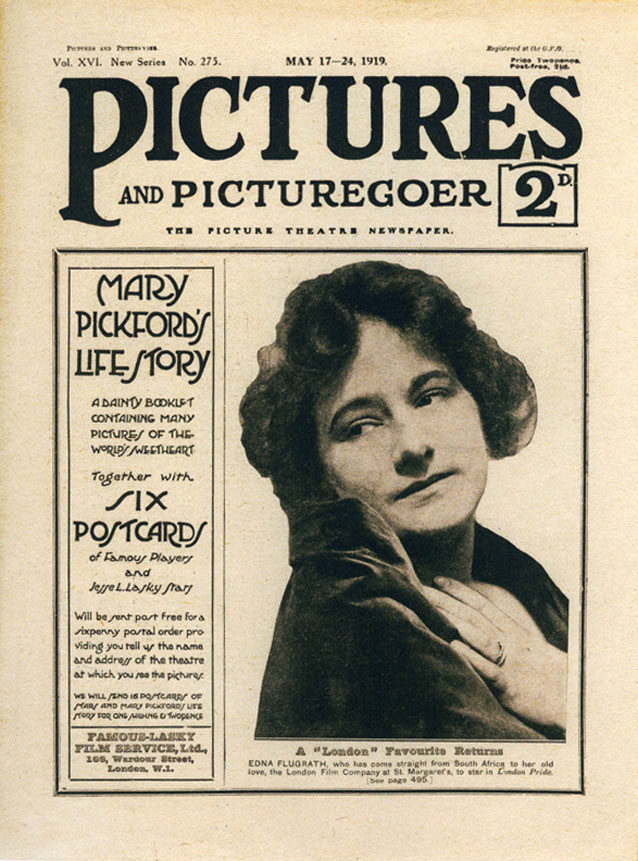
Fig 5.1. Edna Flugrath. Pictures and Picturegoers, 17 May 1919, front cover.
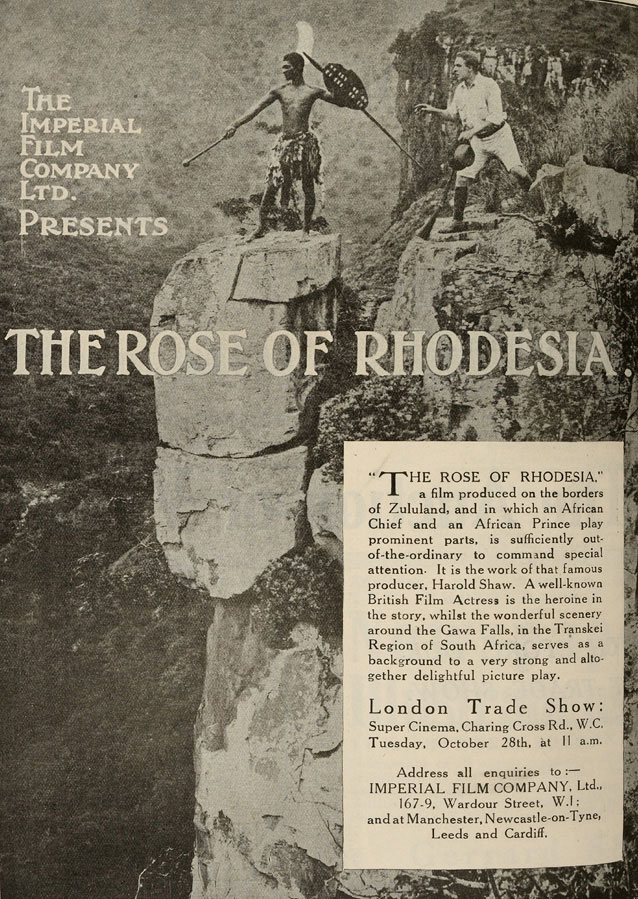
Fig 5.6. Advertisement. The Kinematograph Weekly, 23 October 1919, 86B.
Works Cited
Abel, Richard. 2005. “Classical Hollywood Cinema.” In Encyclopedia of Early Cinema, ed. Richard Abel, 128-31. Oxford: Routledge.
Baillieu, Bill, and John Goodchild. 2002. The British Film Business. London: John Wiley.
The Bioscope (London).
Bordwell, David, Janet Staiger, and Kristin Thompson, eds. 1985. The Classical Hollywood Cinema: Film Style and Mode of Production to 1960. New York: Columbia University Press.
Bourne, Stephen. 1998. Black in the British Frame. Black People in British Film and Television 1896-1996. London and Washington: Cassell.
Burrows, Jonathan. 2001. “Our English Mary Pickford”: Alma Taylor and Ambivalent British Stardom in the 1910s. In British Stars and Stardom: from Alma Taylor to Sean Connery, ed. Bruce Babington, 29-41. Manchester: Manchester University Press.
Cherchi Usai, Paolo. 2000. Silent Cinema: An Introduction. London: British Film Institute.
Convents, Guido. 1986. A la recherche des images oubliées. Préhistoire du cinéma en Afrique, 1897-1918. Bruxelles: OCIC.
———. 2005. “Africa: British Colonies.” In Encyclopedia of Early Cinema, ed. Richard Abel, 12. Oxford: Routledge.
Doyle, Billy H. 1993. Edna Flugrath. Classic Images 215: n.p.
Fuhrmann, Wolfgang. 1999. Lichtbilder und kinematographische Aufnahmen aus den deutschen Kolonien. KINtop. Jahrbuch zur Erforschung des frühen Films 8. Film und Projektionskunst 8: 101-116.
G. B. 1914. “Praise for Harold Shaw.” The Moving Picture World, 23 May.
Gordon, Robert J. “Captured on Film”: Bushmen and the Claptrap of Performative Primitives.” In Images and Empires. Visuality in Colonial and Postcolonial Africa, ed. Paul S. Landau and Deborah D. Kaspin, 212-32. Berkeley: University of California Press.
Grieveson, Lee, and Peter Krämer, eds. 2004. The Silent Cinema Reader. London: Routledge.
Gunning, Tom. 2005. “Cinema of Attractions.” In Encyclopedia of Early Cinema, ed. Richard Abel, 124-27. Oxford: Routledge.
Hammond, Michael. 2006. The Big Show. British Cinema Culture in the Great War 1914-1918. Exeter: University of Exeter Press.
“Harold Marvin Shaw. The Man and His Work.” The Bioscope, 24 February 1916, 759-761.
Higson, Andrew, ed. 2002. Young and Innocent? The Cinema in Britain 1896-1930. Exeter: University of Exeter Press.
The Kinematograph Weekly (London).
Low, Rachael. 1973. The History of the British Film, Volume 3. London: Allen & Unwin.
“Miss Edna Flugrath.” The Moving Picture World, 12 September 1914, 1519.
“Miss Edna Flugrath. The ‘Star’ of the London Film Company.” The Moving Picture World, 27 February 1915, 1304.
Musser, Charles. 1991. Before the Nickelodeon: Edwin S. Porter and the Edison Manufacturing Company. Berkeley: University of California Press.
Nansen, N. 1919. “Die amerikanische Filmdumpinggefahr.” Der Kinematograph 660 (27 August): n.p.
Oksiloff, Assenka. 2001. Picturing the Primitive: Visual Culture, Ethnography, and Early German Cinema. New York: Palgrave.
Ryall, Tom. 2001. Britain and the American Cinema. London: Sage, 2001.
Sandon, Emma. 2002. “Representing ‘African Life’: From Ethnographic Exhibitions to Nionga and Stampede.” In Young and Innocent? The Cinema in Britain 1896-1930, ed. Andrew Higson, 191-207. Exeter: University of Exeter Press.
Sargeant, Amy. 2005. British Cinema: A Critical Survey. London: British Film Institute.
Schomburgk, Hans. 1922. Filmsorgen im tropischen Afrika. Film-Kurier (27 May): n.p.
Strauven, Wanda, ed. 2006. The Cinema of Attractions Reloaded. Amsterdam: Amsterdam University Press.
Endnotes
[1] For a recent discussion of the concept, see Strauven 2006.
[2] For a list of films Shaw directed at the Edison studios, see Appendix E.
[3] On the American domination of the British market, see also Ryall 2001, 23f.
[4] Before signing a contract with Jupp, Shaw briefly worked for Carl Laemmle, whose Independent Motion Picture Company was one of four studios that merged to become Universal Pictures in 1914.
[5] The total of thirty-three films is mentioned in the trade press, see, for example, “Harold Marvin Shaw” 1916, 759. For a list of the titles, see the filmography in Appendix E. After returning to England from Africa, Shaw produced a few more films for LFC before signing a contract with Stoll in 1921. For a more detailed account of some of Shaw’s British films, see Sargeant 2005, 36ff.
[6] Apart from contemporary press articles, data on Edna Flugrath’s biography is scarce (see Doyle 1993).
[7] On the concept of stardom, see Babington 2001.
[8] Email from Elif Rongen-Kaynakci of Nederlands Filmmuseum. The tinting of the intertitles has not been preserved in the restored version.
[9] As Guido Convents has pointed out, capturing images of rail travel in Rhodesia was a way to attract new shareholders to invest in the colonies. Rail also played an important role in the self-understanding of British settlers (Convents 2005, 12).
[10] On the early history of films made in the African colonies, see Oksiloff 2001, Convents 1986 and 2005, Fuhrmann 1999, and Gordon 2002.
[11] We can rule out the possibility that The Rose of Rhodesia was released in the United States under this title. Although it could conceivably have been released under a different title, no press statements supporting this theory have come to light; when The House of Temperley premiered in the United States in 1914, The Moving Picture World called it “more than an ordinary triumph” (23 May 1914), while Shaw’s England’s Menace (1914) was said to have created “a sensation in New York” (12 September 1914, 1519).
Created on: Thursday, 23 July 2009

